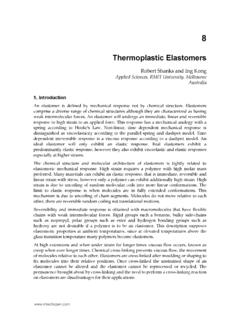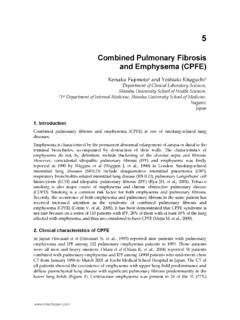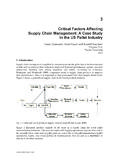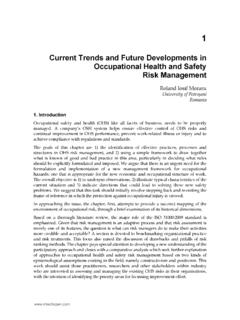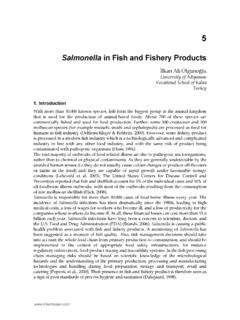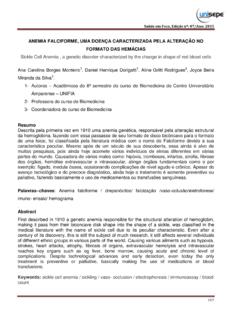Transcription of The Phylogeny and Classification of Anopheles - Open
1 Chapter 1. The Phylogeny and Classification of Anopheles Ralph E. Harbach Additional information is available at the end of the chapter 1. Introduction Anopheles was introduced as a genus of mosquitoes in 1818 by Johann Wilhelm Meigen [1], a German entomologist famous for his revolutionary studies of Diptera. Little was done on the taxonomy of Anopheles until the discovery during the last two decades of the 19th century that mosquitoes transmit microfilariae and malarial protozoa, which initiated a drive to collect, name and classify these insects. In 1898, the Royal Society and the Rt. Hon. Joseph Chamber . lain, Secretary of State for the Colonies of Britain, appointed a Committee to supervise the investigation of malaria. On 6 December 1898, Mr. Chamberlain directed the Colonies to collect and send mosquitoes to the British Museum (Natural History) (Figure 1), and in 1899 the Committee appointed Frederick V. Theobald to prepare a monograph on the mosquitoes of the world, which was published in five volumes between 1901 and 1910 [2 6].
2 As a conse . quence, many new generic names were introduced in an effort to classify numerous new mosquito species into seemingly natural groups. Theobald proposed 18 genera for species of Anopheles based on the distribution and shape of scales on the thorax and abdomen. Four of these proposed genera, Cellia, Kerteszia, Nyssorhynchus and Stethomyia, are currently recognized as subgenera of Anopheles and the other 14 are regarded as synonyms of one or other of subgenera Anopheles , Cellia or Nyssorhynchus. Theobald, however, was not the only person to propose generic names for species of Anopheles . During the first three decades of the 20th century, 37 genera (including the 18 recognized by Theobald) were established for species of Anopheles [7]. As additional new species were discovered, it became increasingly apparent that Theobald's system of Classification was neither practical nor natural. Frederick Knab in North America, one of the early critics of Theobald's Classification , stated that the subject was made needlessly difficult by hasty work and by the sub-division of the old genus Anopheles into numerous ill- defined and fancifully differentiated genera.
3 The intricacies of this system,' unwarranted from both a scientific and practical standpoint, even the trained entomologist could not tread with 2013 Harbach; licensee InTech. This is an open access article distributed under the terms of the Creative Commons Attribution License ( ), which permits unrestricted use, distribution, and reproduction in any medium, provided the original work is properly cited. 4 Anopheles mosquitoes - New insights into malaria vectors safety, and to others it could be no less than hopeless or disastrous [8]. Consequently, during the two decades following the completion of Theobald's monograph in 1910, significant changes were made toward a much more conservative system of Classification , culminating in the reduction of 38 genus-group names (including Anopheles ) to the recognition of the single genus Anopheles . The current subgeneric Classification of Anopheles is based primarily on the number and positions of specialized setae on the gonocoxites of the male genitalia (Figure 2), and this basis of Classification has been accepted since it was introduced by Sir (Samuel) Rickard Christo.
4 Phers in 1915 [9]. Christophers proposed three generic subdivisions, which Edwards [10]. and Francis Metcalf Root [11] formally recognized as subgenera Anopheles , Myzomyia (=Cellia). and Nyssorhynchus. Edwards adopted this system and added subgenus Stethomyia in his classical treatise on family Culicidae published in 1932 [12]. This system recognized Kerteszia as an informal group within subgenus Nyssorhynchus. Kerteszia was elevated to subgeneric status by Komp [13]. Subgenus Lophopodomyia was proposed by Antunes in 1937 [14] and subgenus Baimaia was introduced by Ralph E. Harbach and his colleagues in 2005 [15]. Genus Anopheles currently includes 465 formally named species that are disproportionately divided between seven subgenera: Anopheles (cosmopolitan, 182 species), Baimaia (Oriental, one species), Cellia (Old World, 220 species), Kerteszia (Neotropical, 12 species), Lophopodo . myia (Neotropical, six species), Nyssorhynchus (Neotropical, 39 species) and Stethomyia (Neotropical, five species) [16].
5 Four of the subgenera, Anopheles , Cellia, Kerteszia and Nysso . rhynchus, include the species that transmit human malarial parasites. Most vector species of Anopheles have been found to comprise complexes of sibling species. 2. Classification of genus Anopheles The aim of Classification is to group and categorize biological entities that share some unifying characteristics. Classification has been defined by Ernst Mayr & Bock [17] as The arrangement of similar entities (objects) in a hierarchical series of nested classes, in which each more inclusive higher-level class is subdivided comprehensively into less inclusive classes at the next lower level. These classes (groups) are known as taxa (singular: taxon). The level of a taxon in a hierarchical Classification is referred to as a taxonomic rank or category. Ideally, taxonomic categories should denote equivalent phylogenetic rank; however, in practice they are basically subjective groupings of subordinate taxa that are presumed to represent mono.
6 Phyletic groups of species that are assigned to taxonomic ranks based on shared morphological and biological characteristics that are not a measure of phylogenetic equivalence. For this reason, the taxonomic categories of genus Anopheles , including the formal rank of subgenus, should not be considered to represent equivalent phylogenetic ranks. The Phylogeny and Classification of Anopheles 5. Figure 1. Letter issued from Downing Street on 6 December 1898 directing the British Colonies to collect and send mosquitoes to the British Museum (Natural History). 6 Anopheles mosquitoes - New insights into malaria vectors Figure 2. Subgenera of Anopheles specialized setae on the gonocoxites of the male genitalia (after Harbach & Kitch . ing [18]): A, Anopheles ; B. Baimaia; C, Cellia; D, Kerteszia; E, Lophopodomyia; F, Nyssorhynchus; G, Stethomyia. as, ac . cessory setae; is, inner seta; ps, parabasal seta(e). Infrasubgeneric categories (taxonomic ranks below subgenus) have no formal status under the International Code of Zoological Nomenclature [19].
7 They are convenience categories only, often based on superficial similarities that may not indicate natural relationships. The informal categories used in the Classification of Anopheles include Sections, Series, Groups, Subgroups and Complexes (see Appendix 1). Unlike formal taxonomic categories, which precede the name of the taxonomic unit, for instance family Culicidae, genus Anopheles and species gambiae, the names of informal taxonomic categories follow the name of the taxonomic unit, for example the Pyretophorus Series, Hyrcanus Group or Gambiae Complex, which are written in Roman ( non-italic). script with the first letter capitalized. It should be stressed that both formal and informal taxonomic entities are conceptual constructs invented by taxonomists for the purpose of creating some order in the diversity of species. For example, the species gambiae and the Hyrcanus Group, which are human-conceived taxonomic concepts, cannot be observed as entities or visualized under a microscope.
8 The internal Classification of genus Anopheles (between genus and species levels) is based primarily on the schemes proposed by Edwards [12], John A. Reid & Kenneth L. Knight [20], Alexis Grjebine [21], Gillies & Botha de Meillon [22], Reid [23], Michael E. Faran [24] and Kenneth J. Linthicum [25]. These schemes were reviewed, amalgamated and updated in 1994. [26] and updated again in 2004 and 2012 [27,16 respectively]. The three largest subgenera, Anopheles , Cellia and Nyssorhynchus, are divided into hierarchical systems of informal taxo . The Phylogeny and Classification of Anopheles 7. nomic categories (Appendix 1; examples shown in Figure 3). Subgenus Anopheles is divided into two Sections based on the shape of the pupal trumpet. The Laticorn Section was created for species with a wide funnel-shaped trumpet having the longest axis transverse to the stem, and the Angusticorn Section for species with a semi-tubular trumpet having the longest axis vertical more or less in line with the stem [20].
9 Subgenus Nyssorhynchus is divided into three Sections based on unique combinations of larval, pupal and adult characters [28]. Subgenus Cellia and the Sections of subgenera Anopheles and Nyssorhynchus are divided into Series, the larger Series are divided into species Groups, and some Groups are further divided into Subgroups and species Complexes. Most of the groupings at each level of Classification are presumed to represent natural groups of species, thus implying phylogenetic relationships, but much additional basic taxonomic research is needed before the formal and informal taxa can be firmly established as monophyletic entities. The internal Classification of the genus (subgenera and infrasubgeneric groups) is detailed in Appendix 1. An alphabetical list of all formally named, currently recognized species and their position in the Classification is provided in Appendix 2. Similarly, all currently known sibling species complexes are listed in Appendix 3, and the unnamed and provisionally designated species of the complexes and their position in the Classification are listed in Appendix 4.
10 3. Phylogeny of Anopheles Anopheles is undoubtedly the most studied and best known genus of mosquitoes, largely because of their great impact on human health. As vectors of causative agents of malaria and filariasis, Anopheles mosquitoes have affected the lives of more humans than any other insects. As a matter of fact, Anopheles is one of few groups of eukaryote organisms that have had an impact on human evolution the emergence of sickle cell anemia as a mode of resistance to malarial protozoa. As a result of more than a century of studies by medical entomologists, taxonomists and geneticists, 537 species of Anopheles are currently known and most have been formally named (87%) (Appendix 2), but until recently little work has been done to understand the evolution and phylogenetic relationships of these mosquitoes. Figure 3. Hierarchical Classification (from specific to general) of A. Anopheles freeborni, Freeborni Subgroup, Maculi . pennis Group, Anopheles Series, Angusticorn Section, Subgenus Anopheles ; B.


